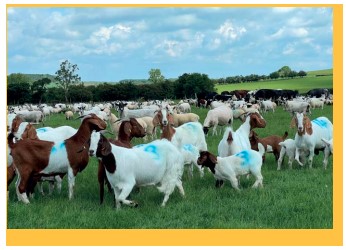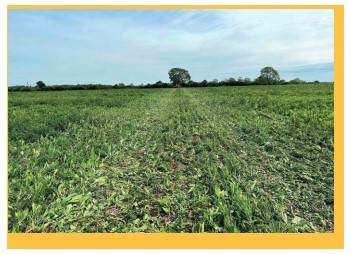It’s amazing how one book can change your life. For 2022 Nuffield Farming Scholar Emily Padfield, this one book was For the Love of Soil by Nicole Masters.
Many describe having their ‘eureka’ moment whilst undertaking their Nuffield Scholarship. Although I am only at the start of my Nuffield journey (having undertaken only a few visits). I believe my ‘epiphany’ occurred before I had applied for my Scholarship. I was standing in the lambing shed in March 2021 (only just over a year ago), busily filling a syringe with Pen and Strep to inject all lambs at birth as we had had an outbreak of joint-ill in our early lambing bunch. I had also sourced a probiotic to then give to each lamb to replenish the gut bacteria I was busily killing with the injection.

At the same time, I was listening on Audible (other audio book providers are available) to ‘For the Love of Soil’ by Nicole Masters. The more I listened, the more I realised that what we were doing had some fundamental flaws. To each problem in my life, whether it be animal or crop health, financial, emotional or human health related, I had always looked for a solution, a cure, a ‘quick fix’. What this book made me realise was that we were looking at everything the wrong way round. We needed to stop the problems happening in the first place, or at least understand why they were happening so we could try to prevent them happening at all. From that moment on, my partner Mark (whose family farm we work together) and I started realising there was a different path we wanted to follow.
Never one to hang around (again one of my many flaws) I started to read everything I could about this ‘new’ way of doing things: Regenerative Farming. The more you read, the more you realise there is truth in the adage ‘there’s nothing new in farming’. Mark started remembering methods and ways his grandfather had used, the number of species he had on the farm before policy and economics governed farms to specialise and expand numbers to become more efficient and profitable. He also remembered the plenitude of life that coexisted here before the use of artificial inputs. He recollected the masses of beetles and insects when combining in his old cab-less combine, seeing the grain teeming with life when unloading the auger. He recalled the health of the livestock without all the different products that are now sold to us at huge expense.
A NEW WAY OF THINKING
The first step we took on our journey was to get regenerative advisor and fellow Nuffield Scholar Ben Taylor-Davies to come and have a chat with us on the farm. We outlined what we wanted to achieve, and it seemed to fit with his way of thinking too. We dug holes, took in-depth soil samples, applied lime and gypsum and bought a sward lifter in a bid to get our compacted clay soils in better health. We had re-introduced cattle five years ago by sourcing dairy beef heifers and steers, keeping the heifers we liked to establish a small suckler herd of 40 or so cows plus followers. Up until then, we had been purely sheep for several years, running 800 plus North Country Mule and Cheviot X ewes, lambing in late February indoors.
We are permanent stock fenced on most of our acreage and field sizes are between 20 to 40 acres. Mark has always loathed electric fencing, so this was a major concern for me as I knew getting involved in strip grazing could cause friction. Since our change in policy, I have since sourced some semipermanent electric fencing from fellow regenerative grazier and Nuffield Scholar Alex Brewster at Powered Pasture and also invested in some geared reels for ease of subdividing fields into smaller paddocks.
Due to a bit of restructuring to allow Mark’s sons some land to start their own businesses on, we reduced sheep numbers to around 450 ewes suit our acreage and started rotational grazing with both sheep and cattle, with regular, if not daily moves.

Our grass management fundamentally changed in this first year. No longer did we set-stock or consider short grazing the ‘best’ thing for sheep like we have for many years. We started to look at multi-species swards and planted our first true herbal ley (failing the first attempt, partly by drilling too early and also having an extremely dry spring). Including chicory in pastures was nothing new on the farm, with Mark having re-established a grass ley with a herb rich ley more than ten years ago.

Our grass management fundamentally changed in this first year. No longer did we set-stock or consider short grazing the ‘best’ thing for sheep like we have for many years. We started to look at multi-species swards and planted our first true herbal ley (failing the first attempt, partly by drilling too early and also having an extremely dry spring). Including chicory in pastures was nothing new on the farm, with Mark having re-established a grass ley with a herb rich ley more than ten years ago.
I also undertook a Savory Institute Holistic Management Course through 3LM at the impressive FarmEd facility established by Cotswold Seeds founder Ian Wilkinson. Amongst many other things this helped me keep a ‘holistic context’ central to decision-making processes.

Early into my regenerative journey I found a small herd of crossbred goats, and later in the summer a good number of chickens. I now know you should never get these species without being fully ready and fenced for them, but you live and learn!

Other changes in farm policy have included dropping fertiliser completely although I have to point out we applied very little to silage crops and we hope to at least reduce cattle housing this coming winter through bale grazing hay before having to bring animals in. This year we also pushed lambing a bit later (partly due to my Nuffield Scholarship Conference being early March) and lambed much of our flock outside. We were lucky with the weather but have been extremely pleased with the results so far. I would be confident to say that unless weather turns really ugly next lambing season we won’t be bringing any sheep indoors from now on.
Rightly or wrongly this year we have direct-drilled our AB9 stewardship option, and although it’s early days we couldn’t have wished for better weather. We sprayed post drilling in a bid to get rid of the considerable thistle burden, and I wait with bated breath to see the outcome. Often it’s difficult to reason between traditionally conventional and regenerative methods and I have to admit to getting myself tied in knots over chemical or tillage use. But I do not think that’s uncommon and there are many more established regenerative farmers struggling with the same dilemmas.
THE START OF MY NUFFIELD JOURNEY
Following encouragement from Ben Taylor-Davies, I decided to apply for a Nuffield Scholarship. I had been aware of Nuffield for many years, having worked as an agricultural journalist before meeting Mark and joining him on the farm. I had always held great reverence for anyone who had undertaken a scholarship, and I didn’t expect to get through the selection process, so was ecstatic to be selected. Many Scholars talk about having ‘imposter syndrome’ and I am still very much still experiencing this, but the Nuffield family is such a tight-knit and welcoming one that we have a fantastic support group to rely on.
My topic is: The mob-grazed flerd: Improving soil, biodiversity and farm incomes. A ‘flerd’ is a mixture of species running together as one flock or herd. We haven’t cracked it quite yet, although we are currently running sheep, cows and goats as one group. The chicken tractor is being built as we speak. I am hoping to visit farmers who are successfully grazing animals together like this, however I appreciate there are limitations so it’s a question of whether it’s even a good idea.

So far, I have travelled to Kansas to the No Till on the Plains Conference (I urge you to attend if you haven’t already), visited many mob-graziers in England and travelled the length of Scotland visiting like-minded livestock farmers. I travel to Portugal in June and in October I, alongside a number of other Scholars, will visit the Savory Institute in Zimbabwe before heading to a number of ranches and facilities across the country before heading onto Zambia. I am and will continue to be forever grateful for the wonderful opportunity that a Nuffield Farming Scholarship has given me to travel and learn how to be a better farmer. I am also passionate about communicating what I learn to others in the industry.
I hesitate to bang the ‘regenerative farming’ drum. I believe in all its concepts and realise it embodies so many aspects, but I am acutely aware that it is dangerous to create a ‘them’ and ‘us’ discourse amongst farmers. We are all striving for betterment together. I just want to be a good farmer. Good to our soil, our environment, our animals, our crops, our consumers and ourselves.
2023 NUFFIELD FARMING SCHOLARSHIPS
• Applications for 2023 Nuffield Farming Scholarships are now open online until 31 July 2022 and can be completed by visiting www.NuffieldScholar.org and clicking the “Apply” button.
• Nuffield are hosting a series of “open sessions” this summer for potential applicants to ask questions and get help to complete their applications.
